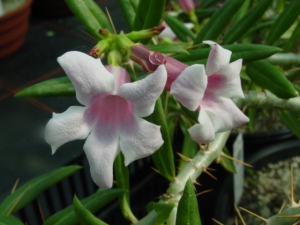A good plant for cactus collectors, because in the winter it can take low temperatures (even a bit of frost) if kept dry. It comes from the Eastern Cape in South Africa and the tuber can grow to a height of 25-30 cm. The branches that grow on top of the tuber can, if they get too large, be cut back. The flowers develop all over the branches, so you do not lose them if you cut the top bits of the branches off. The flowers are similar in shape to those of Adenium obesum, but smaller. The pollinator is probably a moth as the depth of the flower excludes other pollinating insects. When pollinated successfully, twin seed horns will appear which grow to a length of about 5 cm, containing up to 30-40 seeds. The seed has a parachute on the end enabling it to be carried away to a new area to grow. You can tell the difference between an Adenium seed and a Pachypodium seed, because the latter has just one parachute, while Adeniums have two. It is important to remember that the seed from both these species must be sown fairly quickly after collection, because they have a short ‘shelf-life’. It can be kept for a maximum of one year, but the germination will only be about 10%, if you’re lucky. The fresher the seed, the better the germination, possibly up to 100% if sown the first few days after collection.
Pachypodium bispinosum is virtually identical to Pachypodium succulentum when not in flower. To tell them apart, you need to see the flowers; the ones from the succulentum are flatter. In the wild, their localities overlap a little bit, but there is hardly any cross-pollination, probably because the pollination needs different insects.
October 20, 2012
Pachypodium bispinosum
Posted by pshirley under Apocynaceae, Caudex, Collection | Tags: Pachypodium, South-Africa |[3] Comments





